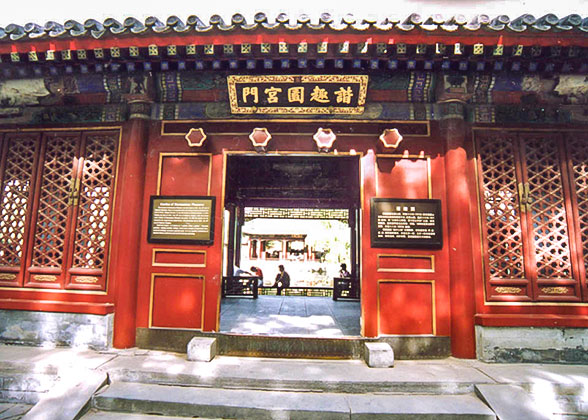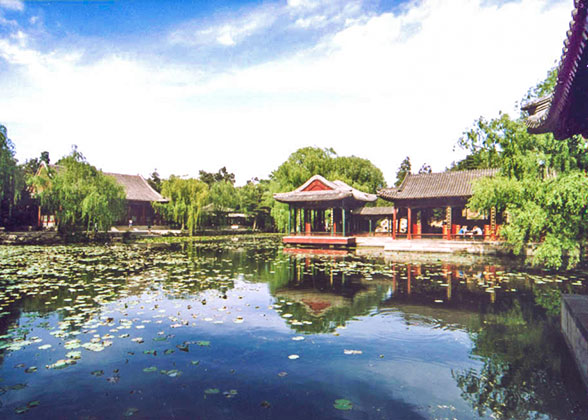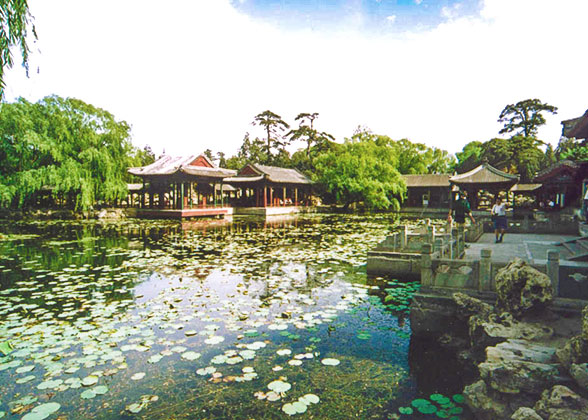Garden of Harmonious Interests (Xiequyuan)
 Situated beside Kunming Lake, at the bottom of the Eastern side of Longevity Hill, the Garden of Harmonious Interests, with its exquisite design and distinctive layout, is known as the "garden in the gardens" Amongst the gardens of Northern China, its style is the most representative of the classical gardens of Southern China.
Situated beside Kunming Lake, at the bottom of the Eastern side of Longevity Hill, the Garden of Harmonious Interests, with its exquisite design and distinctive layout, is known as the "garden in the gardens" Amongst the gardens of Northern China, its style is the most representative of the classical gardens of Southern China.
When Emperor Qianlong (1711-1799) conducted an inspection of South China in 1751, he developed a great affection for the Jichuangyuan Gardens in Wuxi City, Jiangsu Province, and ordered that a similar garden be built in the Summer Palace and named Huishan Garden. This was the precursor to the Garden of Harmonious Interests. In 1811, it was repaired and given its present name. The garden was rebuilt again in 1893 after its destruction in 1860.
Upon entering the palace gate of Garden of Harmonious Interests, visitors would be greeted by a wonderful panorama. Surrounded by slopes on three sides, with a lotus pond at its centre, the garden was comprised of seven pavilions, five halls, numerous corridors and small bridges, all arranged with profusion and elegance. The scene was mirrored in the pond, which was the focus of the garden's natural surroundings, and released a delicate fragrance of lotus. The garden used to be the fishing site of Empress Dowager Cixi . It is said that every time Cixi went to fish, eunuchs secretly dived into the water and hung live fish on her hook, to keep her in good spirits.
The garden is remarkable for its eight settings, each with its particular theme. The eight settings are Zaishi Hall, the Momiao Room, Jiuyun Tower, Danbi House, Shuile Pavilion, Zhiyu Bridge, Xunshi Path, and Hanguang Hole. The essence of each of the eight themed settings (or interests) is as follows:
Interest of Seasons
Interest of Water
 Using the falls from the Back Lake, gardeners built the Yuqin Goroge, through which water trickles across the rocks and makes wonderful sounds, like a musical instrument being played. This is also known as the "interest of sound"
Using the falls from the Back Lake, gardeners built the Yuqin Goroge, through which water trickles across the rocks and makes wonderful sounds, like a musical instrument being played. This is also known as the "interest of sound"Interest of Bridge
Zhuang Zi, one of the philosophers, said: "Look! How happy these fish are!" Hui Zi, the other one, replied: "You are not the fish. How can you know they are happy?" Zhuang Zi replied: "You are not me, how can you know that I know?"
Interest of Calligraphy
Interest of Pavilion
Interest of Painting

Interest of Corridor
Interest of Imitation
![]() Next: Suzhou Market Street
Next: Suzhou Market Street
![]() Related Link: Summer Palace Travel Tips
Related Link: Summer Palace Travel Tips